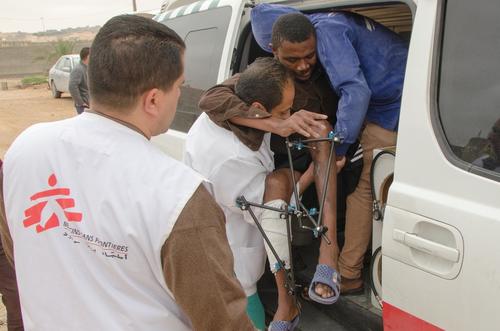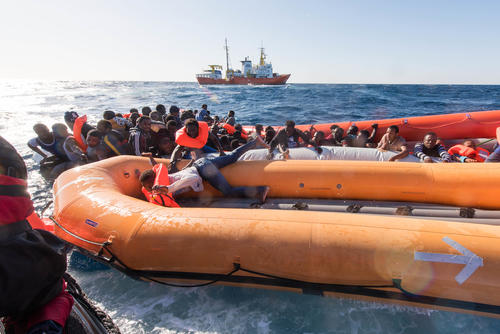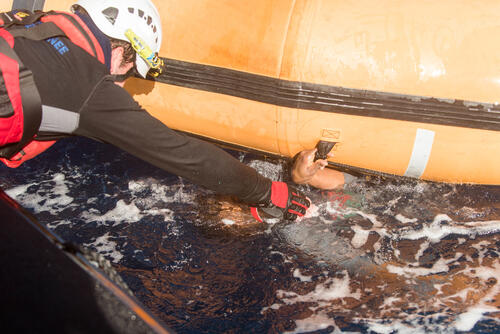Interview with Christophe Biteau, MSF Head of mission in Libya.
Christophe Biteau, head of mission with Médecins Sans Frontières (MSF), has been working in Libya since September 2017. Based on MSF activities to assist migrants and refugees in Bani Walid region and in detention centres located in Khoms and Misrata, he shares his analysis of the current situation.
Since the end of 2017, European and African, as well as Libyan, officials have made an increasing number of declarations about putting an end to the ordeal suffered by migrants and refugees in Libya. Has anything come of them?
The principal measure, facilitated by the International Organization for Migration (IOM), has primarily consisted in stepping up so-called “voluntary” returns of people from Libya to their countries of origin. A distinction should be made between two different situations in the current context. There are migrants detained in “official” centres and migrants who are abducted and held in clandestine prisons. In November, there were close to 17,000 detainees in the first category. Their so-called “emergency evacuation” began several months ago and, since November 2017, around 15,000 of them have been repatriated. A positive development, when it allows people trapped in Libya really wanting to return home to do so.
All the same, we have to question the voluntary nature of these repatriations, given arbitrary detentions that leave people no other alternative. As for the United Nations Refugee Agency (UNHCR), the organisation has evacuated just over 1,000 of the most vulnerable among the refugees. Most have been taken to Niger where they wait for another country to provide them asylum. The majority of the over 50,000 people registered with UNHCR in Libya are from Syria and have been in the country for some time, but there are many more refugees and asylum-seekers passing through Libya who remain under the radar. They are among the ones who are abducted, locked up, sometimes even murdered. It’s difficult to estimate their number but, according to some observers, there are 700,000 migrants, refugees and asylum seekers in the country.
What has changed in the field?
The main change we’ve seen is a fall in the number of people held in official detention centres to between 4,000 and 5,000. This has made detention conditions a little less unbearable than they were six months ago, especially the problems caused by overcrowding. But so many problems still have to be addressed and the very few international organisations in the country are almost exclusively based in Tripoli and are blind to them. Our teams providing medical care and support in several Libyan detention centres meet detainees who tell them they’re still waiting for assistance and they don’t know what’s going to become of them. The graffiti on their cell walls reflects only too well their uncertainty.
But most of all, nothing’s being done to put an end to the ordeals suffered by migrants and refugees mainly outside official detention centres. In addition, people who risk their lives by crossing the Mediterranean Sea in an attempt to leave Libya are still, with the help of European states, being brought back to the country where they find themselves exposed to all kinds of violence.
Let’s take the example of a young man or woman crossing the Mediterranean in an attempt to get to Europe and their boat is intercepted by the Libyan coastguard. What happens in this situation?
People intercepted at sea by the Libyan coastguard are disembarked on the Libyan coast and taken to detention centres. UNHCR and IOM teams have divided up between them the 12 disembarkation sites they have access to and conduct health assessments. The survivors are then, in theory, taken away to detention centres. There’s no specific provision for the most vulnerable who, at this point, should be given special treatment and not be subjected to arbitrary detention that jeopardises their health even more. We’re still seeing young children from boats intercepted at sea brought to detention centres. It also must be said that the distinction between official and clandestine networks is not always that clear. Anything can happen. Someone brought back from sea to Libya can all too soon end up once again in the clutches of people traffickers and the torture can begin all over again.
For many people, being sent back to the country they came from is not an option and criminal networks are their only alternative to be able to find refuge and a better life in Europe. These networks, which Europe claims to be dismantling, have a monopoly on organising the movements of very vulnerable people, who have no other alternative. Why are Eritreans—90 per cent of whose asylum claims are accepted in Europe—obliged to embark on such hazardous and arduous journeys? Doing everything to retain or return to Libya people seeking to flee just leads to even more suffering.

How widespread is the trafficking? There’s been talk of an industry of abduction and torture in Libya. Is this still the case?
We have no way of saying how many people are held in clandestine prisons, but kidnapping migrants and refugees, and using torture to obtain ransoms is not only widespread but it’s probably increasing. It replaces incomes from local economies impacted by the lack of cash in Libyan banks. Those who survive the clandestine prisons are financially, physically and mentally ruined and, if it’s ever going to be possible, they need time and support to recover.
MSF doesn’t have access to clandestine prisons but assists people who manage to escape. For example, we work with a local NGO to provide primary care in a migrant shelter in Bani Walid. Some migrants have legs broken in several places, burn injuries and severely beaten backs. Libyan organisations working alongside us are as horrified as we are. While it’s impossible to say how many migrants and refugees arrive in Libya, pass through Bani Walid, and endure this nightmare, we’re treating just as many survivors during our consultations as last year. Just last week a survivor who’d arrived at the hostel the previous day told us, “I’ve endured 2 months, 3 weeks, 1 day and 12 hours of hell.” Although their health often requires them to be hospitalised, admission is often delayed because public hospitals oblige us to test patients beforehand for infectious diseases. Every month we give 50 body bags to a local NGO who want to give a decent burial to migrants and refugees found dead in the Bani Walid area. They say they’ve buried over 730 bodies since last year. But we can’t conclude that this corresponds to the number of people who have died from the atrocities and dangers endured passing through this specific area. The death toll is definitely much higher.





